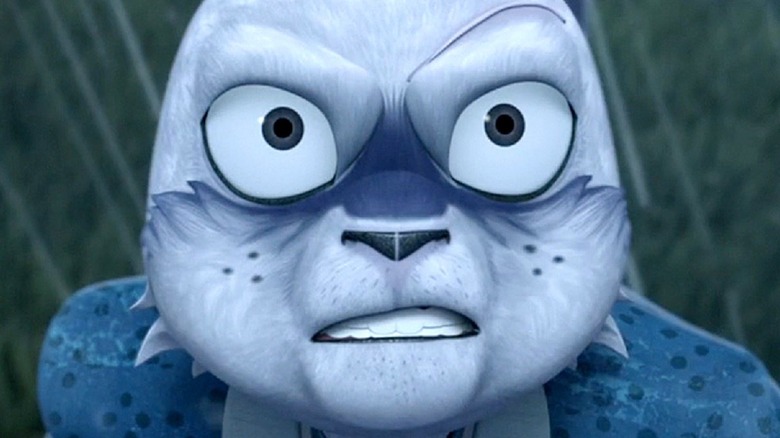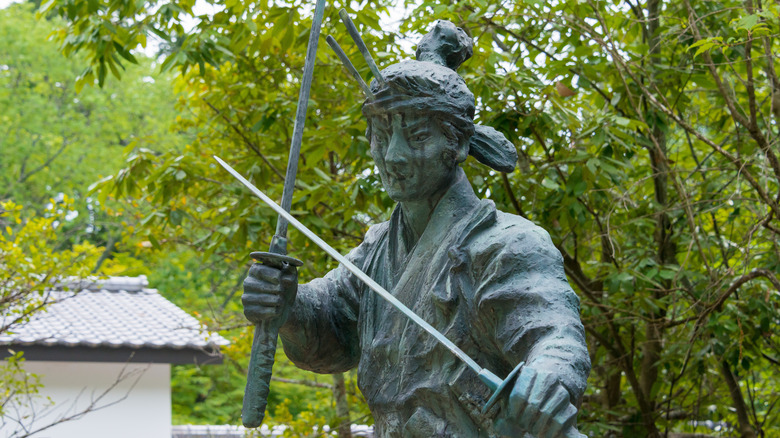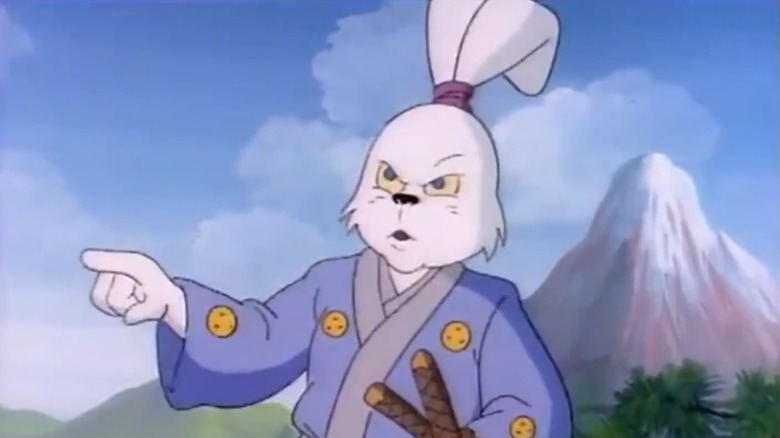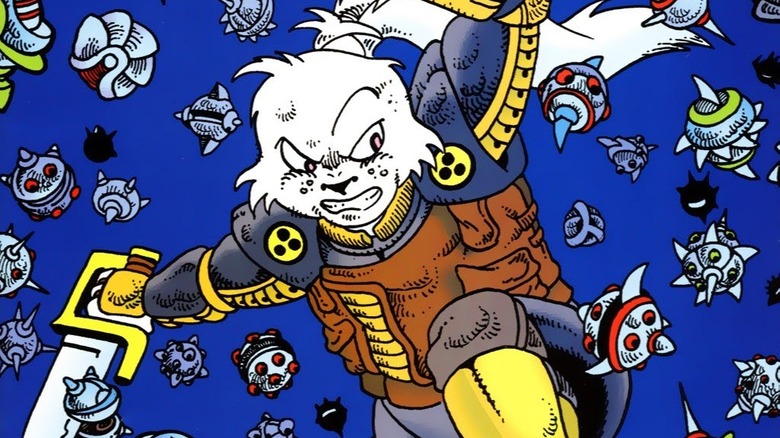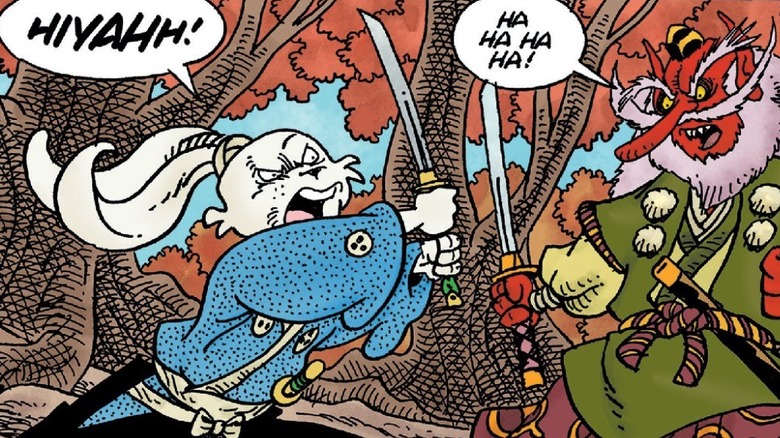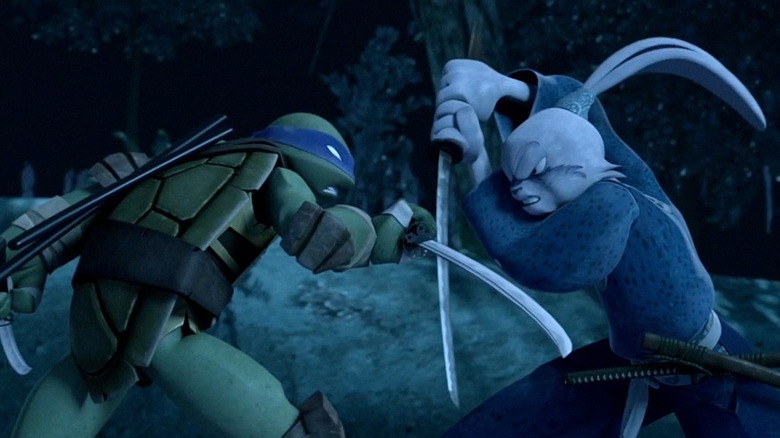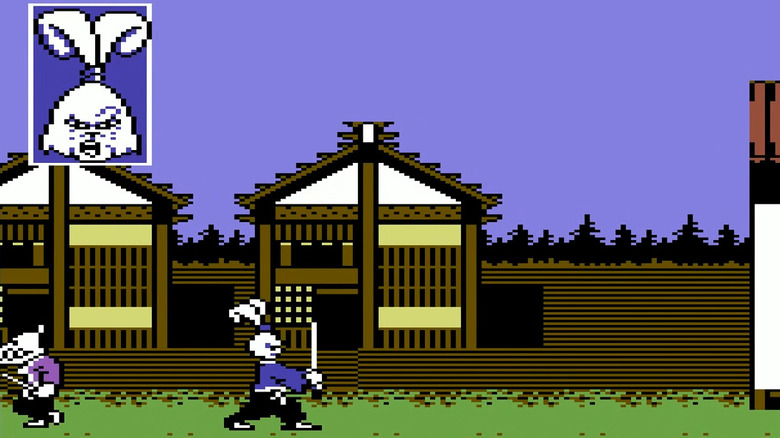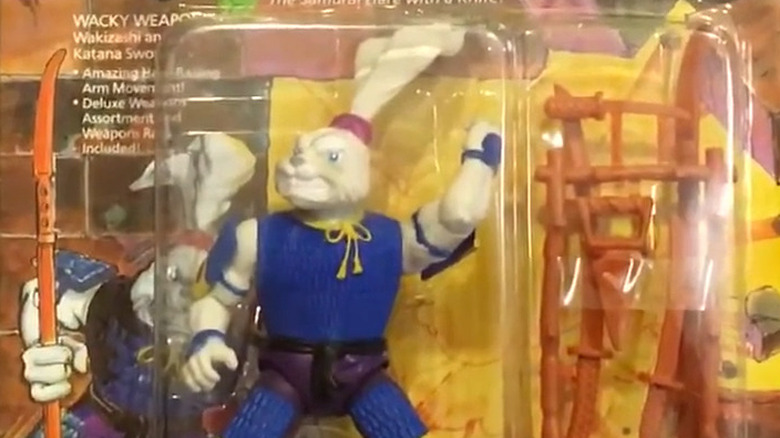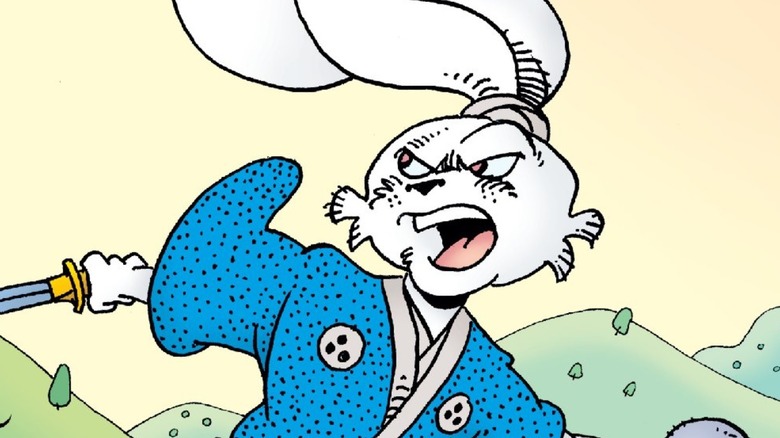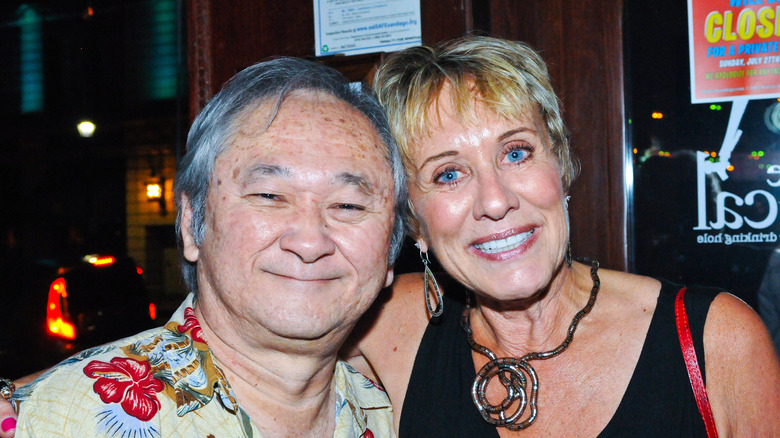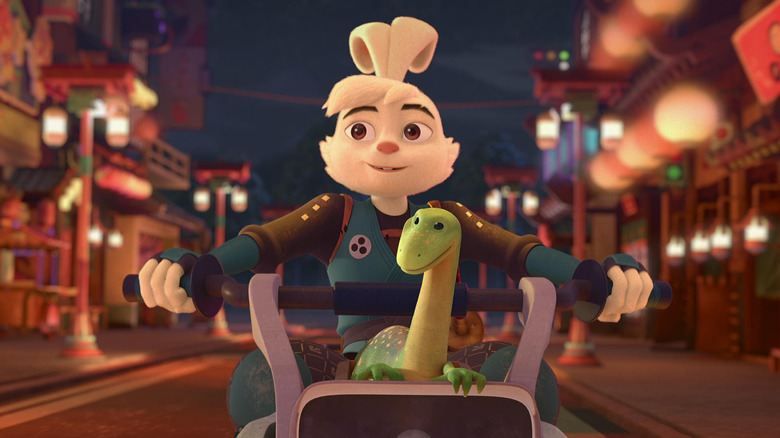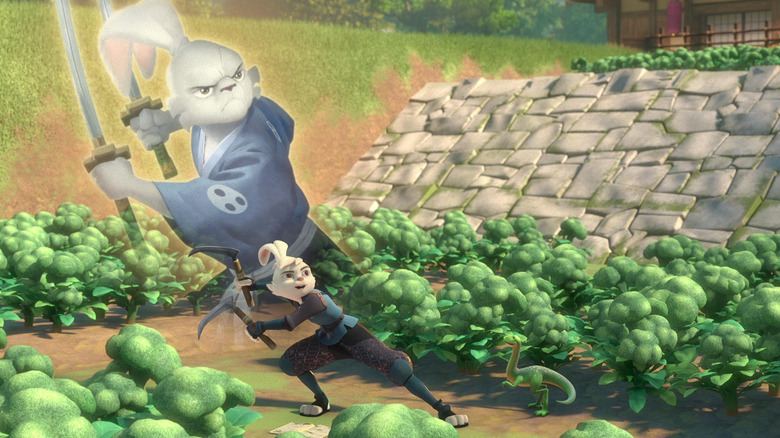The Untold Truth Of Miyamoto Usagi
For over three decades, comic book fans have been following the swashbuckling adventures of Miyamoto Usagi, the ronin rabbit that leads the "Usagi Yojimbo" series. Created by Stan Sakai in 1984, Usagi was a case of right place, right time: He arrived in an era when independent comics were experiencing a boom, with the likes of "Teenage Mutant Ninja Turtles" and "Groo the Wanderer" proving popular. Like those properties, "Usagi Yojimbo" built a dedicated following. Miyamoto Usagi continues to resonate with a global audience, resulting in the character's inclusion in IGN's Top 100 Comic Book Heroes.
This samurai rabbit has a long and fascinating history that includes successful crossovers, a video game you've probably never heard of, and even a trek into the cosmos. With so much to cover, it's time to dive deep into the past and follow the white rabbit as we uncover the untold truth of Miyamoto Usagi.
Miyamoto Usagi was inspired by a real ronin
Anthropomorphic characters aren't unusual in comic books and animated TV shows. Whether it be "Street Sharks," "Thundercats," or "Teenage Mutant Ninja Turtles," there have been numerous examples over the years. A samurai rabbit fits the same mold, but Miyamoto Usagi wasn't an entirely unique creation. In a conversation with Innovation & Tech Today, creator Stan Sakai revealed that Miyamoto Musashi, a fabled samurai from the early Edo period, served as the main inspiration for the "Usagi Yojimbo" comics.
"He's quite famous in Japan with books, cinema, and manga detailing his life and legend," Sakai said of Musashi, who became an artist after retiring from his life as a ronin. "I had wanted to do a story on Miyamoto Musashi and, while I was playing with character designs, I drew a rabbit with his ears tied up in a chonmage [samurai topknot]. The aesthetic was striking and I've worked with Usagi ever since."
The TMNT animated series got his name wrong
A samurai rabbit versus ninja turtles? To paraphrase a famous "Futurama" meme: "Shut up and take our money!" It made perfect sense for Miyamoto Usagi to show up in the 1987 "Teenage Mutant Ninja Turtles" animated series, especially since both IPs were creator-owned. Stan Sakai was on friendly terms with Peter Laird and Kevin Eastman (the creators of "Teenage Mutant Ninja Turtles") even before they hit the big time, so any collaboration was always bound to run smoothly. At least, in theory.
The makers of the "Teenage Mutant Ninja Turtles" cartoon took some creative license with Usagi's nuanced backstory, and they also decided to change his name. On the show, he's referred to as Usagi Yojimbo, which, of course, is the name of the comic book series, not the lead character. The showrunners likely believed that your average kid was more familiar with the title of the comic (which translates to "rabbit bodyguard") and opted to stick with that.
A Space Usagi animated show received a pilot
When in doubt, send your character into outer space. That's exactly what Stan Sakai did in "Space Usagi," a space opera spinoff of the main "Usagi Yojimbo" comic book. In this series, the titular character is a descendant of the great samurai rabbit Miyamoto Usagi, and his grand adventures take place in the stars. Sounds like the perfect premise for an animated series, right? Well, according to the official "Usagi Yojimbo" website, it nearly happened.
A pilot episode was produced, with veteran voice actor Jim Cummings taking on the role of Space Usagi. It was all good to go, but there was a major problem: No toy companies were prepared to put up the money for the series. Due to the failure of another space rabbit TV show of that era, "Bucky O'Hare and the Toad Wars!," there was no interest in seeing if "Space Usagi" would turn out any different.
Stan Lee was a big fan
The name Stan Lee is synonymous with Marvel. Whether it be his work in shaping Marvel Comics or his many cameos in Marvel movies over the years, it's safe to say that Lee was Mr. Marvel in the eyes of the world. He lived and breathed the company, but Lee wasn't afraid to praise non-Marvel properties, and he was a big fan of a certain sword-wielding rabbit. On the homepage of Stan Sakai's official website, there's a quote from Lee, who wrote the following: "I think 'Usagi Yojimbo' is one of the most original, innovative, well-executed comic books anywhere to be found."
That's certainly high praise from the late comic book legend, but it should come as no surprise since Sakai and Lee had worked together for over 25 years. On Sakai's Twitter account, he mentioned how he had lettered the "Spider-Man" newspaper strip and how Lee would often send him notes and sketches. One time Lee even sent him a hilarious picture of Spider-Usagi, the ultimate crossover that we didn't know we needed until now.
How Usagi is culturally important
Stan Sakai's "Usagi Yojimbo" is a highly entertaining and engaging comic book, but it has another purpose: The series showcases Japan. "Heavily researched and rich in detail, Sakai's storylines mix both humor and drama to tell adventures that include authentic Japanese history and culture," the Japanese American National Museum said. Miyamoto Usagi's exploits have celebrated this proud country's fascinating past and introduced a global audience to stories and concepts they might not have been familiar with before.
In 2011, the Japanese American National Museum in Los Angeles hosted a three-month exhibition that took attendees into the heart of Stan Sakai's "Usagi Yojimbo" universe. The show featured exclusive artwork, pivotal covers from the different eras of the comics, best-selling action figures, and even contributions from other artists. A documentary was also put together to celebrate Sakai, the visionary who took an independent comic about a samurai rabbit into the mainstream public consciousness.
Miyamoto Usagi vs. Leonardo
Considering Miyamoto Usagi's close ties to the Ninja Turtles, many fans have wondered who would win in a swordfight between the samurai rabbit and the dual katana-wielding leader of the TMNT, Leonardo. The two have had their battles over the decades — in both comics and animated shows — but their contests normally end in a tie when they realize they're fighting for the same side and should form an alliance instead.
In 2017, Stan Sakai got another stab at a crossover comic book, and he knew exactly what fans wanted to see. "Usagi and Leo, because they both use a sword, have always had a unique relationship," Sakai told Entertainment Weekly. "Personally, I like Leo; he's my favorite. Fans always ask me for a fight between Usagi and Leo, and there is one here. They have different styles, ninja versus samurai, and I had a ball with it." Once again, there was no outright winner between the two (they get stopped by Master Splinter), but it was still a fun match-up for the ages.
Usagi starred in a Commodore 64 game
While the Teenage Mutant Ninja Turtles got an animated series and toyline before Usagi, the ronin rabbit starred in his own video game before they did. "Samurai Warrior: The Battles of Usagi Yojimbo" was released on the Commodore 64 in 1988. Sure, it wasn't a world-renowned beat 'em up like the Turtles' first arcade game, but it was a pretty big deal at the time and legitimized the character in popular culture. The developer was Beam Software, a company that was very much into comic book properties.
"We were into '2000 AD,' 'Love and Rockets,' 'Raw,' 'Critters' (where cult title Usagi first appeared), and so on," programmer Doug Palmer told Retro Gamer. "'Usagi' was lying around, everyone enjoyed it, and Melbourne House founder Fred Milgrom spotted something." In 2015, Usagi received another video game in the shape of "Usagi Yojimbo: Way of the Ronin," developed and published by Happy Giant. Made in the style of the classic TMNT arcade title, this button-bashing retro brawler dropped to mixed reviews.
The interesting origins of the Usagi action figure
In the late 1980s, "Teenage Mutant Ninja Turtles" action figures exploded onto the market. Kids everywhere wanted to collect all the wild and wonderful characters on offer. TMNT toys are said to have generated around $1.1 billion from 1988 to 1992, one of the best-selling lines of the time. Since Usagi appeared on the TMNT animated show, he also formed part of one of the toy series. As revealed by Stan Sakai during a 1996 interview with "The Comics Journal," the Usagi action figure proved to be a big hit.
"Basically, Peter [Laird] and I were just sitting together and talking and suddenly he turned to me and said, 'You want a toy?' and I said, 'Sure!' — you know, thinking he was going to give me a toy," Sakai recalled. "Half a year later, the toys were on the shelves, and the first year, we sold two and a half million Usagi toys nationally. It did pretty well." Sakai also revealed that he rejected the first design he was shown because it was far too muscular. He said: "It was like Rob Liefeld drawing Usagi, Usagi's head on He-Man's body."
Miyamoto Usagi's real age and eye color explained
According to Stan Sakai (via an FAQ on the Usagi website), Miyamoto Usagi is in his late 20s. Rabbits obviously age differently from humans, something fans of the "Usagi Yojimbo" series have pointed out on numerous occasions. The furry ronin clearly ages like a human, however — rabbits can live for up to 18 human years, so if Usagi was his 'rabbit' age, he'd only be two years old.
Another topic that fans have pondered over is Usagi's eye color. In some comics, it's pink, while in others, it's blue. So which is it? Sakai addressed this in another FAQ, giving a typically tongue-in-cheek answer. "Usagi's eyes are indeed pink, but he tends to wear tinted contact lenses, hence the discrepancy," he joked. "No, actually, I tend to color his eyes pink, while Tom Luth (the main colorist on 'Usagi Yojimbo') colors them blue. We'll try to be more consistent in the future."
Stan Sakai's favorite Usagi Yojimbo stories
Holding all the creative control over the "Usagi Yojimbo" franchise has allowed Stan Sakai to tell many stories over the years, some quaint and beautifully simple, others wildly outlandish. While fans have their favorites, it turns out that Sakai himself also has a few that he holds dearer than others.
"I'm particularly fond of 'Kite Story' that is currently included in 'Usagi Yojimbo Book 5: Lone Goat and Kid' published by Fantagraphics Books," the comic book creator told Innovation & Tech Today. "It required extensive research into the art of kite making. I suppose as someone who has spent years honing my skills, it was fun to examine another artisan."
His other favorite story is quite different — 2015's "Senso," meaning "war" in English. Loosely based on H.G. Wells' "The War of the Worlds," this sci-fi storyline "takes place in Usagi's future when Martians attack feudal Japan," Sakai explained. "It was just pure fun, and I could play with established characters in a way I can't in the regular 'Usagi' stories."
Stan Sakai had full approval of the Netflix show
The legend of "Usagi Yojimbo" will live on thanks to the CGI animated Netflix show "Samurai Rabbit: The Usagi Chronicles," which follows Yuichi Usagi, a descendant of Miyamoto. With any adaptation, there's always the natural fear that it will deviate from the source material and be something completely unrecognizable to fans. Stan Sakai revealed this won't be the case in a Comic-Con@Home 2021 panel, telling viewers that he remains extremely protective of the franchise and demands a certain level of quality.
"I approve everything and have input at every stage of the animation process, from the story to the design to animatics, even to the choice of voice actors," Sakai said. "So, you know, it's something I'm very involved in." James Wan is on board as an executive producer, someone who knows all about world building through his work on "Aquaman." Perhaps "Samurai Rabbit: The Usagi Chronicles" will be the start of a Usagi Universe on Netflix. Maybe we'll finally get that "Space Usagi" show after all.
Stan Sakai has plenty of other Usagi descendants in mind
With "Space Usagi" and "Samurai Rabbit: The Usagi Chronicles," the legend of Usagi already extends beyond the original hero, the ronin Miyamoto. There's the potential to go into the future and see other characters take up the mantle — think of it like "Batman Beyond" but with bunnies. Stan Sakai has revealed to Stranger Worlds that he actually has many ideas for potential Usagi descendants.
"I was thinking 21st century investigative reporter," Sakai said. "Also, a 1930s pulp hero — 'Usagi: Shadow of the Rabbit,' like 'The Shadow.' There are others in the Old West, where Usagi's descendant goes out into the 1800s. Yes, there's a whole bunch." As Sakai explained, he owns the character, so the sky is the limit when it comes to inserting characters into new timelines. And the best part? He doesn't need to stick to the confines of any genre because the suits told him to. He said: "I can do stories about mystery, romance, adventure, all kinds."
